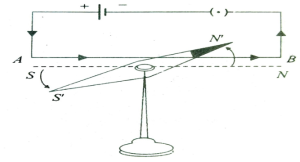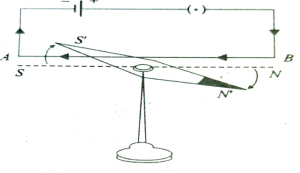Concept of magnetic field
A magnet is a material which has the property to attract small pieces of iron, cobalt, nickel, etc. The magnet material has a specific space around it, within which its influence can be experienced. However, all magnetic phenomena result from forces between two charges in motion.
The concept of the magnetic field was introduced to explain the interaction between two charges in motion. The interaction is described in 2 stages:
- A moving charge creates a magnetic field in the space surrounding it
- The magnetic field exerts a force on a moving charge or a current in the field
A magnetic field is a vector quantity. When an electric field varies with time, then the magnetic field is created. The force experienced by a moving charge in a magnetic field is perpendicular to its velocity and the magnetic field.
We relate the magnetic field by two closely related vector fields called B (Magnetic field density) and H (magnetic field intensity).
The B-field (Magnetic field density)
The force on an electric charge, also known as Lorentz, depends on two vector fields. The first is the electric field, which describes the force on a stationary point charge. In the second, the magnetic field describes the force which is proportional to both the direction and speed of the charged particle. Thus, the Lorentz force law (after the Dutch physicist Hendrik A. Lorentz) deals with the force exerted on a charged particle moving through an electric field and magnetic field with velocity.
Lorentz force law:
F=qE+q(vB)
Here F is the force on the charged particle, q is the electric charge on the particle, E is the electric field, B is the magnetic field and v is the velocity of the particle. The direction of the force on the charge can be determined by the right-hand rule. Using the right-hand rule, if pointing the finger in the direction of the moving charge, and pointing the middle finger in the direction of the applied magnetic field then the thumb points in the direction of the force due to the magnetic field pushing the moving charge.
The first term in the Lorentz equation is from the theory of electrostatics and says that an electric force experienced by a charged particle in an electric field E is given by
Felectric=qE
And the force experienced by a particle in a magnetic field B moving with velocity v is
Fmagnetic=q(vB)
The H-lines (Magnetic field intensity)
The magnetic field H is defined as
H=B ⁄ μ0-M
Where μ0is the permeability in a vacuum, and M is the magnetization vector.
In a vacuum, magnetic field density B and magnetic field intensity H are proportional to each other. The SI unit of the H-field is amperes per meter (A/m) and Oersted (Oe) in the CGS unit.
History of a magnetic field
The theory of magnetic field was first noticed by an Italian Jurist. Gian Domenico Romagnosi in 1802, which was rediscovered in 1820 by a Danish physicist, Hans Christian Oersted. His observation described the relation between electricity and magnetism.
Then, Ampere showed that the parallel wires attract or repel each other when the current flowing in them is in the same or different direction. Finally, Jean-Baptiste Biot and Felix Savart announced empirical results that a current-carrying long wire exerts a force on a magnet which is inversely proportional to the perpendicular distance from the wire to the magnet.
In 1825, Ampere published his model on magnetism that proposed that due to perpendicularly flowing current in a loop and showed the equivalence of the electric currents to magnets.
In 1831, Michael Faraday formulated the law of induction which described the induced electromotive force as generated when a conductor is placed in a changing magnetic field.
Illustrations of a magnetic field
Magnetic field lines:
Magnet field lines are a representation of the information available from the Magnetic Field. These lines are imaginary lines to represent the magnetic fields. The Magnetic field lines represent the direction of the magnetic force. The magnitude of the field is indicated by the density of the field lines. If we consider 2 magnets, then the magnetic field is stronger and crowded near the poles of the magnets and the magnetic field lines are much closer to each other. When we move away from the magnet poles, the field lines become weak and less dense.
The illustration of a magnetic field is done by an observation explained by Oersted’s experiments. Oersted considered a magnetic needle pivoted over a stand. A wire is held parallel to the needle and connected to a cell.
- The north pole of the magnetic needle was deflected towards the west when the current flows from the south to the north through the wire which is held above the needle

- The north pole of the magnetic needle was deflected towards the east when the current flows from the north to the south through the wire, which is held above the needle.

- The deflection of the magnetic needle was again reversed when the wire was placed below the needle
- The magnetic needle comes back to its initial position when the current in the wire stops flowing
From this experiment, the needle gets deflected when a current-carrying conductor is near the needle. As a magnetic needle deflects only by a magnetic field, this gives evidence that a current-carrying conductor produces a magnetic field around it.
Conclusion
A material which is magnetic in nature has a specific area around it where an effect of magnetism is experienced which we call a magnetic field. The force experienced by a moving charge in a magnetic field is perpendicular to its velocity and the magnetic field.
The theory of magnetic field was first noticed by an Italian Jurist. Gian Domenico Romagnosi in 1802, which was rediscovered in 1820 by a Danish physicist, Hans Christian Oersted. His observation described the relation between electricity and magnetism.
 Profile
Profile Settings
Settings Refer your friends
Refer your friends Sign out
Sign out






